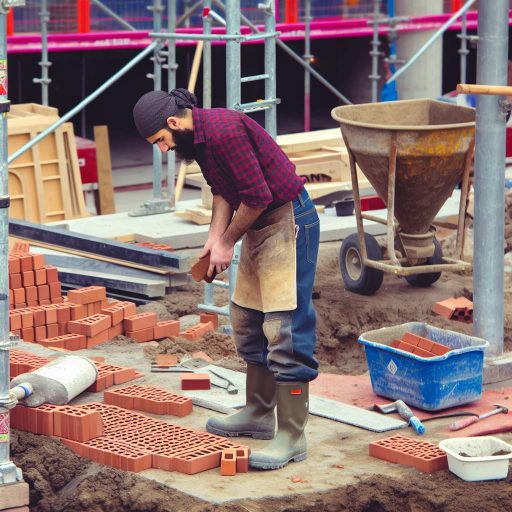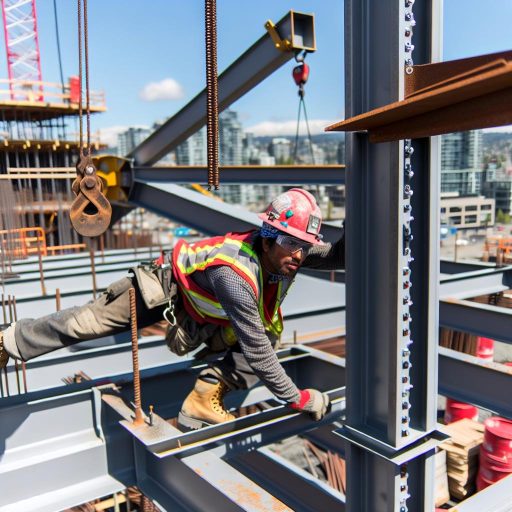Understanding the Importance of Communication in Construction Teams
Enhancing Teamwork
Effective communication enhances teamwork among construction workers.
It fosters collaboration between bricklayers and other trades.
When everyone shares information, projects run smoothly.
Team members can quickly address any issues that arise.
Reducing Errors
Clear communication helps reduce mistakes during construction.
When bricklayers understand the plans, they execute them better.
This approach minimizes the need for costly rework.
Moreover, it ensures compliance with safety standards.
Building Trust
Good communication builds trust within the team.
Trust leads to increased morale and motivation.
When team members feel heard, they contribute more actively.
This culture of openness strengthens team dynamics.
Facilitating Problem-Solving
Communication is crucial for effective problem-solving.
When issues arise, teams need to discuss solutions openly.
Bricklayers should feel comfortable expressing concerns.
This responsiveness fosters a proactive work environment.
Improving Productivity
Enhanced communication directly impacts productivity levels.
When instructions are clear, tasks are completed efficiently.
This efficiency leads to timely project completions.
Consequently, it reduces stress on the crew.
Key Communication Skills for Bricklayers
Active Listening
Active listening is a crucial skill for bricklayers.
This skill ensures that you understand instructions clearly.
Try to fully engage when others speak to you.
Make eye contact and nod to show understanding.
Avoid interrupting the speaker during conversations.
Unlock Your Career Potential
Visualize a clear path to success with our tailored Career Consulting service. Personalized insights in just 1-3 days.
Get StartedThis shows respect and fosters better communication.
Additionally, summarizing what you’ve heard can clarify points.
Ask questions if something is unclear to you.
This practice enhances collaboration among team members.
Clarity in Communication
Clear communication is vital in the construction industry.
Use straightforward language when relaying instructions.
Be specific about what needs to be done and when.
Avoid using jargon that might confuse your colleagues.
Providing visual aids can help convey complicated ideas.
Furthermore, confirm that everyone understands the message.
Using written notes can also prevent misunderstandings.
Additionally, repeat key points to emphasize their importance.
This clarity helps avoid costly errors on job sites.
Utilizing Body Language and Nonverbal Cues on the Job Site
The Importance of Nonverbal Communication
Nonverbal cues greatly impact how messages are received.
They can convey emotions and intentions effectively.
Bricklayers must understand these signals on-site.
Common Nonverbal Cues to Recognize
- Facial expressions often reveal true feelings.
- Gestures can emphasize or contradict spoken words.
- Posture communicates confidence or uncertainty.
How to Enhance Your Nonverbal Communication
Be mindful of your body language while working.
Maintain an open posture to appear approachable.
Use eye contact to build trust with your team.
Additionally, nodding can signal agreement or understanding.
Interpreting Your Teammates’ Nonverbal Signals
Observe your colleagues’ body language carefully.
Look for signs of frustration or discomfort.
These cues can help you adjust your approach.
Responding appropriately fosters a collaborative environment.
Cultural Considerations in Nonverbal Communication
Nonverbal signals can vary greatly across cultures.
Be aware of cultural differences among team members.
This understanding can prevent miscommunication.
Always respect personal space and comfort levels.
Practicing Nonverbal Communication Skills
Engage in role-playing exercises with your team.
Provide feedback on each other’s body language.
Use video recordings to analyze your own nonverbal cues.
Regular practice leads to improvements over time.
Effective Communication for Successful Projects
Effective communication is essential for successful projects.
Utilizing body language enhances teamwork on-site.
Investing time in these skills pays off in productivity.
Learn More: Exploring the Demand for Bricklayers in Canada
Effective Use of Construction Jargon and Terminology
Understanding Construction Jargon
Construction jargon enhances communication among bricklayers.
Using precise terminology fosters clarity on job sites.
Additionally, it reflects professionalism and expertise.
Common Terms in Bricklaying
Familiarity with essential terms is crucial for bricklayers.
Here are some common terms to know:
- Mortar: The substance used to bind bricks together.
- Course: A horizontal layer of brick in a wall.
- Brick Bond: The pattern in which bricks are laid.
- Scaffolding: Temporary structure to support workers and materials.
How to Use Jargon Effectively
Using jargon effectively requires practice and awareness.
Make sure to adjust your language to your audience.
For example, don’t use technical terms with clients unfamiliar with them.
Instead, use simple language to ensure understanding.
Benefits of Mastering Jargon
Mastering construction jargon provides several advantages.
- Improved teamwork as everyone understands each other.
- Streamlined communication reduces the risk of errors.
- Enhanced reputation among peers and clients.
Continuous Learning and Adaptation
Bricklayers should continually learn new terms and practices.
Staying updated with industry trends is essential.
Furthermore, attending workshops can enhance vocabulary and skills.
Explore Further: How to Find Bricklaying Apprenticeships in Canada
Strategies for Communicating with Project Managers and Supervisors
Be Clear and Concise
Effective communication starts with clarity.
Always express your thoughts in a straightforward manner.
Avoid using technical jargon unless necessary.
Use simple language that everyone can understand.
Use Active Listening
Active listening is crucial for effective dialogue.
Focus on what the project manager says without interrupting.
Confirm your understanding by restating key points.
This practice builds rapport and trust.
Provide Regular Updates
Regular updates keep everyone informed of progress.
Share information on task completion and any obstacles faced.
This transparency promotes teamwork and accountability.
Consider using project management tools for better tracking.
Ask for Feedback
Feedback is essential for improvement.
Encourage managers to provide constructive criticism.
Use their input to enhance your work quality.
Regular feedback sessions can strengthen relationships.
Maintain Professionalism
Always communicate in a professional manner.
This includes being respectful and courteous in conversations.
Your demeanor reflects your commitment to the project.
Handling conflicts calmly demonstrates leadership qualities.
Adapt to Different Communication Styles
Each project manager may have a unique communication style.
Observe and adapt to their preferences accordingly.
This flexibility will enhance your interactions substantially.
Utilize Visual Aids
Visual aids can clarify complex ideas.
Consider using diagrams or charts when necessary.
Visual elements help convey information more effectively.
They also keep the audience engaged during discussions.
Gain More Insights: Why Roofers Are Essential to Construction Projects

Handling Conflicts and Misunderstandings
Recognizing Conflict
Conflicts often arise from misunderstandings on the job site.
These issues can lead to lowered morale and productivity.
Recognizing the signs of conflict early is crucial.
For instance, changes in communication patterns may indicate tension.
Pay attention to non-verbal cues from team members.
Addressing Issues Directly
Once conflict is identified, address it directly and calmly.
Start conversations in private to maintain confidentiality.
Being open and honest leads to better understanding.
Ask questions to clarify misunderstandings and gather perspectives.
This approach encourages team members to express their feelings.
Finding Common Ground
Finding common ground is essential to resolving conflicts.
Encourage all parties to focus on shared goals.
Highlighting common interests promotes teamwork.
Discuss possible solutions as a group to foster collaboration.
This method helps in achieving mutually acceptable outcomes.
Implementing Solutions
After reaching an agreement, implement the solutions quickly.
Follow up to ensure that the resolution is effective.
Regular check-ins can help maintain open lines of communication.
Encourage feedback to improve conflict resolution processes.
This continuous improvement will strengthen team dynamics.
Learning from Conflicts
Every conflict presents an opportunity for learning.
Reflect on what caused the misunderstanding initially.
Analyze how it was addressed and what could have been improved.
Share experiences with the team to promote collective growth.
This proactive approach fosters a culture of open communication.
Explore Further: Career Growth Potential for Metal Fabricators in Canada
Leveraging Technology for Improved Communication
Choosing the Right Communication Apps
Choosing the right communication apps enhances collaboration among bricklayers.
Popular apps like Slack and Microsoft Teams streamline project discussions.
These platforms allow for real-time communication and file sharing.
Consider user-friendliness when selecting an app for your team.
Moreover, ensure it supports notifications to keep everyone informed.
Utilizing Project Management Tools
Project management tools improve task assignments and tracking.
Tools such as Trello and Asana help organize tasks visually.
These systems allow bricklayers to monitor progress easily.
Clear task descriptions foster accountability among team members.
In addition, project timelines enhance deadlines awareness.
Implementing Video Conferencing for Site Meetings
Video conferencing tools like Zoom facilitate remote meetings.
These platforms bridge communication gaps for off-site discussions.
Users can share screens to review project plans in detail.
This method saves travel time and ensures all voices are heard.
Furthermore, video conferencing supports visual demonstrations effectively.
Using Digital Blueprints and Models
Digital blueprints enhance clarity and reduce miscommunication.
Software like AutoCAD allows teams to view updated plans easily.
3D models provide a comprehensive view of the project and specifics.
This visualization helps identify potential issues before they arise.
Consequently, everyone on the team can work from the same page.
Encouraging Feedback and Regular Updates
Regular feedback promotes a culture of open communication.
Encourage bricklayers to share their insights on processes and tools.
Moreover, schedule weekly check-ins for updates on progress.
Such meetings can address concerns and foster team bonding.
Ultimately, a feedback-focused environment enhances productivity.
Creating a Collaborative Work Environment through Open Dialogue
Encouraging Open Communication
Open communication fosters trust among team members.
It allows bricklayers to voice their concerns freely.
Encouragement from supervisors promotes active participation.
Regular meetings can facilitate this communication.
Modern technology helps streamline discussions.
Establishing Clear Expectations
Clearly define roles and responsibilities from the outset.
This clarity minimizes confusion on the job site.
Each team member should understand their tasks.
Setting realistic goals enhances productivity.
Moreover, it promotes a sense of ownership.
Utilizing Constructive Feedback
Frequent feedback helps team members improve their skills.
Use specific examples to make feedback actionable.
Encourage a culture of giving and receiving feedback.
Positive reinforcement motivates individuals to excel.
Additionally, this practice nurtures professional growth.
Building Strong Interpersonal Relationships
Strong relationships enhance teamwork and cooperation.
Organize team-building activities outside of work hours.
Social interactions can break down barriers.
When team members connect, they communicate better.
Fostering camaraderie creates a positive work environment.
Active Listening Techniques
Listening is as important as speaking in communication.
Encourage team members to practice active listening skills.
This ensures everyone feels heard and valued.
Summarizing what others say validates their input.
Additionally, it clarifies understanding among team members.
Additional Resources
6 Keys to Better Construction Communication
NCCER: National Center for Construction Education & Research




